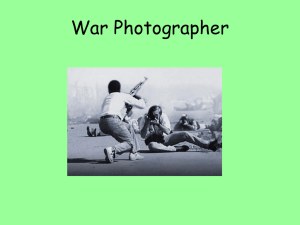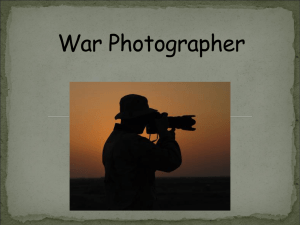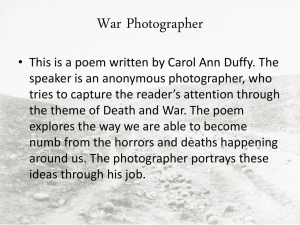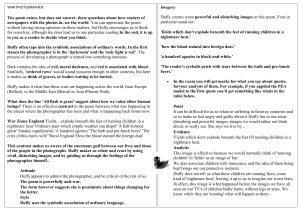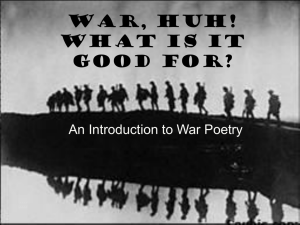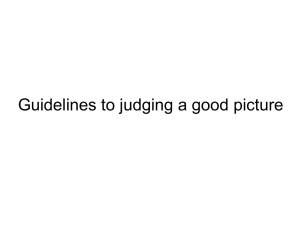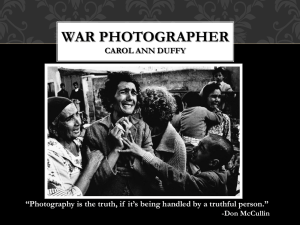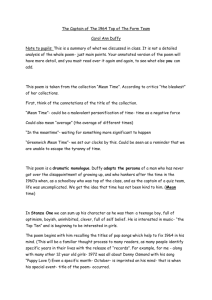War Photographer Poem Analysis: Themes & Quotes
advertisement
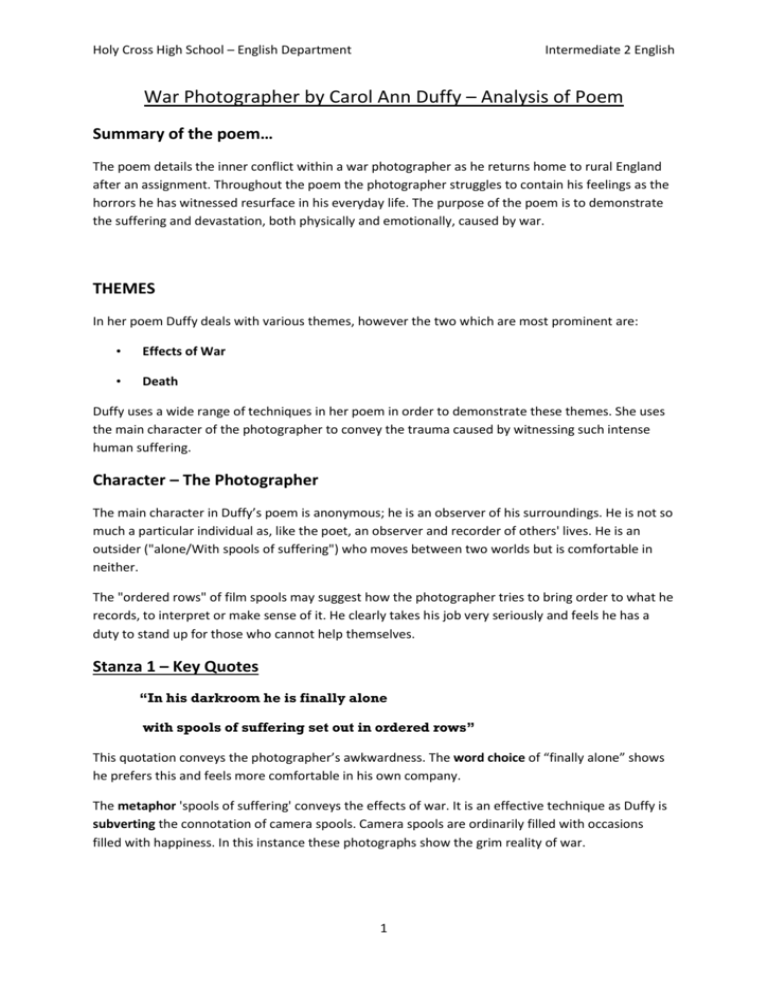
Holy Cross High School – English Department Intermediate 2 English War Photographer by Carol Ann Duffy – Analysis of Poem Summary of the poem… The poem details the inner conflict within a war photographer as he returns home to rural England after an assignment. Throughout the poem the photographer struggles to contain his feelings as the horrors he has witnessed resurface in his everyday life. The purpose of the poem is to demonstrate the suffering and devastation, both physically and emotionally, caused by war. THEMES In her poem Duffy deals with various themes, however the two which are most prominent are: • Effects of War • Death Duffy uses a wide range of techniques in her poem in order to demonstrate these themes. She uses the main character of the photographer to convey the trauma caused by witnessing such intense human suffering. Character – The Photographer The main character in Duffy’s poem is anonymous; he is an observer of his surroundings. He is not so much a particular individual as, like the poet, an observer and recorder of others' lives. He is an outsider ("alone/With spools of suffering") who moves between two worlds but is comfortable in neither. The "ordered rows" of film spools may suggest how the photographer tries to bring order to what he records, to interpret or make sense of it. He clearly takes his job very seriously and feels he has a duty to stand up for those who cannot help themselves. Stanza 1 – Key Quotes “In his darkroom he is finally alone with spools of suffering set out in ordered rows” This quotation conveys the photographer’s awkwardness. The word choice of “finally alone” shows he prefers this and feels more comfortable in his own company. The metaphor 'spools of suffering' conveys the effects of war. It is an effective technique as Duffy is subverting the connotation of camera spools. Camera spools are ordinarily filled with occasions filled with happiness. In this instance these photographs show the grim reality of war. 1 Holy Cross High School – English Department Intermediate 2 English Stanza 1 – Key Quotes continued… “ with spools of suffering set out in ordered rows” “spools of suffering” also suggests the importance of these photographs. Duffy is suggesting that these spools contain a reality of war which should be shared. She is suggesting that these people should not be left to suffer alone, however unfortunately that is exactly what happens. The repetition of the 's' sound is like the camera winding on, mirroring the photographer’s memories “winding on” as he recalls them. The spools are set out in 'ordered rows' this goes back to the idea of death as the spools are laid out in the same way that coffins would be. “The only light is red and softly glows” The red light is used by Duffy to symbolise many things. Firstly, the red may symbolise the blood which is lost in war. As the photographer develops the film he compares himself to a Priest. This continues the idea of death which is present throughout the poem. “All flesh is grass” This metaphor is taken from the Old Testament of the Bible. In the Bible Isaiah compares how short human life is with The Word of the Lord which lasts forever. Before this line Duffy lists cities which have been affected by War. In doing this Duffy is reinforcing that living in a war zone human life is more fragile and even shorter. Stanza 2 – Key Quotes “He has a job to do. Solutions slop in trays beneath his hands which did not tremble then though seem to now.” Duffy’s use of sentence structure through the short sentence reinforces how seriously the photographer takes his job. The second stanza contrasts the photographer's calmness when taking pictures with his attitude as he develops them. If his hands shake when he takes pictures, they won't be any good, but in the darkroom he can allow his hands to tremble. The darkroom allows him to release his emotions. 2 Holy Cross High School – English Department Intermediate 2 English Stanza 2 – Key Quotes cont. “Solutions slop in trays” "Solutions“ here has a double meaning. It refers literally to the developing fluid in the trays, but also suggests the idea of solving the political problems which cause war - "solutions" which he does not have, of course. Duffy contrasts the fields in England with those abroad - as if the photographer thinks English fields unusual for not being minefields. The image is shocking, because he thinks of land mines as exploding not under soldiers but under "the feet of running children". The image is deliberately shocking as it shows the innocent lives which are lost due to war. “Rural England. Home again to ordinary pain which simple weather can dispel” This quotation once again shows the effect of war on the photographer’s mental state. He struggles to adapt back into “normal” life having witnessed such horrors. The war has made everyday life seem meaningless and trivial in comparison to the suffering experienced by others. The use of sentence structure helps to emphasise the contrast the poet is creating between mundane life back in leafy England and the shocking reality of a war zone. Stanza 3 – Key Quotes “Something is happening. A stranger’s features Faintly start to twist before his eyes, A half formed ghost.” What "is happening" in the third stanza is that an image is gradually appearing as a photo develops. "Ghost" is ambiguous (it has a double meaning). It suggests the faint emerging image, but also that the man in the photo is dead (which is why the picture was taken). Duffy’s use of imagery here is particularly shocking and clearly highlights the consequences of war. The memories the photographer is reliving have clearly traumatised him as he details the atrocities he witnessed. This shows the effects of war on both the living (the photographer) and the dead (the dead man). “He remembers the cries of the man’s wife, how he sought approval without words” 3 Holy Cross High School – English Department Intermediate 2 English The photographer recalls the reaction of the wife on seeing her husband die. He is not able to ask for permission to take the picture (either there is no time or he does not speak the language or both) but he seeks "approval without words". It is as if he needs the wife’s approval in order to record the event while the blood stains "into foreign dust". Stanza 4 – Key Quotes “A hundred agonies in black-and-white” The word choice of “agonies” clearly demonstrates the effects of war on peoples’ lives. This word shows the suffering and pain caused by violence. Once again Duffy’s words have double meaning when she uses “black and white”. On one level they could refer to the black and white photographs the photographer has just developed. However, they could also refer to black and white as a symbol for good and evil. Also, Duffy seems to be suggesting the importance of telling the truth in “black and white”. “The reader’s eyeballs prick with tears between bath and pre-lunch beers” Very cynical tone is conveyed from these lines. Duffy is suggesting that although the images may evoke some sympathy from the reader’s this sympathy is short lived. Duffy is suggesting the selfishness and self absorption of society as these people’s suffering is not as important as their “pre-lunch beers”. “From aeroplane he stares impassively at where he earns a living and they do not care” The photographer and Duffy’s feelings towards society are clearly demonstrated in these final lines. There is a sense of pointlessness as the photographer leaves on another assignment knowing full well that those who will see his images “do not care”. There is a feeling of sympathy/admiration for the photographer as he continues to share the suffering of the helpless despite the lack of compassion and indifference of society. What to take from this poem… Duffy obviously feels something in common with her subject - she uses the photographer’s experience to voice her own criticism of how comfortable Britons look at pictures of suffering, but do not know the reality. She sees the photographer (far removed from the paparazzi of the tabloids) as both priest and journalist. The reader's response to the Sunday newspaper is almost like going to church - for a while we are reminded of our neighbour's suffering, but by lunchtime we have forgotten what we learned. 4
